Abstract
The present study is devoted to the analysis of the smart services (SS) and re-engineered processes (RE) implementation at the Dubai Electricity and Water Authority (DEWA). SS and RE are defined and dwelled upon, after which a literature review on the topic is used to develop the questionnaire for a survey at DEWA. The questionnaire is used to solicit the opinions and perceptions of DEWA stakeholders who have been employed in DEWA SS and RE adoption. The findings are analyzed and discussed, and a recommendation is proposed for the improvement of SS and RE implementation. In particular, it is suggested that additional and more extensive training of managers and employees as well as the use of the newly gained experience to develop new strategies for employee engagement and planning or to update existing ones.
Introduction
Nowadays, increased efficiency and quality of service is a must for the majority of businesses and the government (Bhatnagar, 2009; Dolicanin, Kajan, Randjelovic, & Stojanovic, 2014; Morton-Huddleston, 2012). One of the means of increasing these parameters is the implementation of smart services (SS) and related re-engineered processes (RE). The present paper is devoted to a case study of SS and RE at Dubai Electricity and Water Authority (DEWA), which is carried out by soliciting the opinions of the stakeholders of the body.
The paper includes a literature review, an extensive methodology discussion, findings, conclusions, recommendations, limitations, and appendices. Appendix A contains the questionnaire that was used in the study. Appendix B contains the tables that are collected there for convenience in referring. Appendix C contains a resume (brief) of the paper.
Literature Review
As of late, the UAE has been actively employing SS in the form of e-government, and Dubai is not an exception in this respect (Dubai Electricity and Water Authority [DEWA], 2016; Kusek, Verheijen, & Bhatti, 2014). As a result, the introduction of SS at DEWA has been informed by theory and practice and promoted by the government, which allows situating the event in a literature review on the topic.
Smart Services
Service is regarded as a “smart” one if it employs modern technologies and innovative approaches or models in order to improve its ability to reach its goal, which is typically concerned with customer satisfaction that can be achieved through the development of various service parameters like effectiveness or speed (Al-Jenaibi, 2016; Dolicanin et al., 2014). With respect to the government, SS are concerned with public services that are enhanced through the use of technology in order to improve their effectiveness as well as the transparency of the actions of the government (Hashmi & Khanna, 2016; Kusek et al., 2014). Both these outcomes are increasingly demanded from modern governments, which explains their interest in SS and smart government that can also be termed as e-government (Morton-Huddleston, 2012).
The implementation of SS is typically correlated with the significant change that often restructures the processes of an organization. As a result, SS is correlated with the re-engineering process that can be defined as the noticeable structural change (Davenport, 2013; Mola, Pennarola, & Za, 2015). Apart from that, the success of SS largely depends on the way it has been implemented (Bhatnagar, 2009, p. 79). As a result, the importance of process re-engineering for SS cannot be overestimated.
E-Government
The idea of smart e-government has been developing since the 1970s together with the general access of the public to computer technologies (Al-Jenaibi, 2016, p. 21). The notion of e-government basically defines the use of modern communication technologies by the government, but it may be suggested that the common feature of using these technologies consists of the aim to “transform relations with citizens, businesses and other arms of government” (Kumar, 2015, p. 81), which is carried out by developing these relations, increasing the quality and quantity of information provided to citizens, enhancing the government’s effectiveness, and generally improving the services that are offered by the body or institution (Hashmi & Khanna, 2016; Kusek et al., 2014 ). Apart from that, the governments that employ e-governmental technologies also often expect that the innovation will contribute to other aspects of its activities, eventually resulting in the improvement of the country’s financial and environmental sustainability (Dolicanin et al., 2014). It can be suggested that SS in the field of government is not equal to e-government, but the two notions are closely related.
Smart Services and Dubai
The UAE in general (and Dubai in particular) has been developing SS in the field of governmental services primarily through the notion of e-government (Al-Jenaibi, 2016). The success of the country’s initiative is demonstrated by the increase in customer satisfaction, which also results from improved efficiency, in particular, enhanced speed (Al-Jenaibi, 2016). Similarly, employees typically report satisfaction and a willingness to proceed to work with the UAE e-government systems and initiatives (Al-Jenaibi, 2015). However, some issues in the field are still reported; in particular, Al-Jenaibi (2016) describes the lack of a clear universal vision and centralized coordination of SS the UAE e-government efforts. Weak leadership is generally a significant issue and challenge in SS and especially RE; it can be related to managerial and technological issues alike (Burke, Yu, & Mckenna, 2014). Also, Al-Jenaibi (2015) has discovered several issues that typically arise during the adoption of e-government, which includes the costs, the lack of IT skills, and the development of evaluation activities. Also, Al-Khouri (2011) reports that the achievement of the goals of the innovation is also typically a challenge that is not always successfully managed. The mentioned issues will be considered in the course of the DEWA investigation in the present research and will inform the creation of the questionnaire.
The Literature on the Topic and the Method and the Present Paper
The bulk of literature on the topic has been growing in the past years, and it is being discussed by practitioners and theorists (International Business Publications, 2016; Kusek et al., 2014). In particular, the study of specific cases of SS implementation, which, for example, is carried out by Kusek et al. (2014), appears to be a valid strategy in the field. The present study also intends to discuss a case study (that of DEWA), and apart from that, it is going to be dedicated to insider research: the research that is carried out by an employee of the company. There are both advantages and disadvantages to this type of research: It involves a person who can be biased with respect to the settings but also possesses certain preexisting knowledge on it (Coghlan & Brannick, 2014). As a result, the new case study that is explored through insider research is likely to contribute to the growing field of knowledge and to be of interest to the practitioners within DEWA and outside of it.
Research Design
Title
The title of the proposed research can be phrased as follows: “Smart Services and Re-Engineered Processes of Dubai Government: A Study of DEWA Stakeholders.” It is a new, reviewed definition of the topic that reflects a change towards a field that is more applicable to the case study and of greater interest to the researcher. Also, the researcher’s position as a stakeholder was emphasized. Still, the new title reflects the topic and scope (location) of the research like the old one.
It is noteworthy that the new topic is better researched than the previous one, and as a result, there is no shortage of information that was encountered during the study of the previous topic (Davenport, 2013; Dolicanin et al., 2014; Mola et al., 2015). The fact that the topic is more researchable also makes it more attractive.
Brief about the Title
Nowadays, greater attention is paid to the effectiveness and transparency of governmental activities (Morton-Huddleston, 2012), and as a result, new means of improving a government’s ability to fulfill its functions are being developed, one of which is the “smart services” notion. The “smartness” of a phenomenon is assessed through its use of innovative models and technologies, which leads to the improvement of the process’s ability to fulfill its aim (Dolicanin et al., 2014; Mola et al., 2015). As a result, “smart services” are concerned with the use of modern approaches and technologies in the area of service, which for smart government, involves public services (Kusek et al., 2014). Dolicanin et al. (2014) also suggest that a smart government is supposed to take into account the environmental sustainability of a country and its financial development, which can be regarded as governmental functions as well (p. 19). Just like the majority of innovative processes, the implementation of SS is likely to involve re-engineering (RE) (Mola et al., 2015, p. 66), which can be defined as a change that is directed at the structure of a process or organization and which is often related to technology implementation and use (Davenport, 2013).
It is apparent that SS in the field of governmental services is connected to the concept of electronic government (e-government). Basically, the term describes the use of information and communication technologies by governments, but it is typically concerned with various attempts at enhancing the processes with the help of modern technologies (Bhatnagar, 2009, pp. 1-2). In other words, e-government can be regarded as a term that intersects with SS.
E-government has become very popular in developed and developing countries (International Business Publications, 2016, p. 69); it is widely adopted in the Middle East, including the UAE (International Business Publications, 2016; Kusek et al., 2014). DEWA (2016) has been supporting governmental activities that are aimed at government services improvements (including the Dubai Plan 2021), which implies that it is interested in developing SS and related RE (para. 7). As a result, the company is a suitable location for the study.
One of the frameworks that can be used with SS is the TM Forum Application Framework (TAM) that is aimed at telecommunication applications (Holecek, Brabec, & Tikovsky, 2014), which constitute an important part of SS, especially in the field of e-government (Kumar, 2015). Apart from that, it has been discovered that TM Forum frameworks are typically widely applicable and flexible, which makes them usable with a variety of businesses (Holecek et al., 2014, p. 2). TAM was developed to help in the management of telecommunication SS in the modern highly competitive and unstable market with the primary aims of ensuring efficiency and performance, and one of the steps towards this end is a successful implementation of an SS (Burke et al., 2014, pp. 1-2; Holecek et al., 2014, pp. 2-4). Thus, TAM also highlights the significance of implementation, which is emphasized by many authors (Davenport, 2013; Bhatnagar, 2009). Concerning the specifics of TAM, it offers guidelines to be used at different stages of implementation, of which the current research especially focuses on problem handling because the investigation of SS implementation challenges and their resolution are major research objectives (Holecek et al., 2014, pp. 2-4). Thus, the application of TAM to the topic informs its discussion.
Research Problem
A research problem can be described as an “issue that leads to the need for a study” (Creswell, 2013, p. 108). For the current research, the problem of the implementation of SS is going to be considered within the context of DEWA. The successfulness of the models of SS and e-government largely depends on their implementation, including the activities that are related to the adjustment of organizational structure and assimilation of new elements (Bhatnagar, 2009, p. 79). Given the fact that RE typically involves significant changes, it can also be regarded as a high-risk activity that needs appropriate management (Davenport, 2013). As a result, the current study will consider DEWA’s perception of the problem and its response to determine possible difficulties and appropriate solutions.
A study of one company (and, therefore, one implementation process) is not very generalizable, but it is of interest to researchers and practitioners, as it might describe a situation (issue, solution) that might fit other organizations (Creswell, 2013, p. 204). Therefore, the study is an exploratory work that aims to discover and describe an example of SS implementation.
Research Questions
The specific research questions for the research problem are going to consider various aspects of the implementation of SS and the re-engineering of government services, which may include the following elements.
To what extent is the call for SS is recognized at DEWA? The reasons for DEWA’s attitude as well as its manifestations and their positive or negative impacts on implementation processes are going to be considered here.
What is the organization’s response? What are the specific models and activities of SS that are employed or are planned to be employed at DEWA? What are the RE processes that have been involved?
What is the mechanism of the implementation process? Here, the whole system with the implementation team, their responsibilities, methods, and monitoring, and control tools are to be discussed.
How was the implementation carried out? Here, the focus will be on the challenges and issues as well as the specific means of mitigating them. The section can be regarded as the lessons that have been learned by the body throughout implementing the SS.
What are the outcomes of the implementation? The specific, measurable outcomes that demonstrate the results of the team’s work should be mentioned in this part.
How successful is DEWA at the implementation of the models and activities? The answer to this question will differ from the previous one as it is supposed to evaluate the changes, not just state them. The team metrics can be used, but if they are unavailable, they can be substituted by specifically developed ones based on the best practices in the area (Bhatnagar, 2009). Also, the level of customization of the program and the extent to which it is capable of satisfying the company’s needs must be investigated (Klischewski, 2011). The question of how “smart” the services have become is applicable as well; it is necessary to consider the goals of the project team as well as the actual changes in the performance of the body.
What is the future of the DEWA innovation? Is it durable? Is it modifiable or will it have to be discarded when new technology comes along? Resilience and flexibility are necessary for a model in the modern rapidly changing world (Klischewski, 2011).
The questions offer a very extensive, in-depth study, but they may be modified as more information on the topic and DEWA is discovered. If any of them appears to be impossible to pursue, it may be omitted; if additional opportunities for research arise, they may be used, and if a part of DEWA’s implementation process deserves particular attention, it may be employed as the main and only aspect that will be studied.
The motive of the Research
I am a worker and a consumer of DEWA, which means that I am personally interested in the proposed research in several ways. The study in the area is likely to make me more knowledgeable with respect to e-government and its implementation, which implies that my professional knowledge and qualities will receive a boost. As a result, the research holds a promise of improving my professional performance and, possibly, even enhancing my career growth. Apart from that, I intend to make the research practically applicable, which means that there is a chance that the results will be useful for my organization. I do not hope to produce a groundbreaking discovery, but I tend to think that workplace-based studies are capable of contributing to the improvement of the said workplaces. Therefore, I might benefit from the research if my company’s processes become more advanced. In this case, I will experience positive outcomes as a customer (due to better services) and a worker (due to better processes and the pride for my organization). Naturally, contributing to the development of my company is an achievement of its own, which is an important motive for the current research.
Apart from the above-mentioned professional growth, the research will help me to develop some core skills, for example, those related to the information collection, management, and presentation as well as reporting and writing skills. Moreover, I am interested in the topic, and the opportunity to research SS and RE excites me. To sum up, I am going to benefit from the current research in multiple ways, and these benefits together with my personal interest in the topic constitute my wish to carry it out.
Other stakeholders that are going to be involved include the employees who have been directly involved in the process of SS implementation and RE. Their motivation is likely to be similar; the study offers them another opportunity to reflect on their work, discuss it, and learn about the opinions of others. While the questionnaire is anonymous, the final report will be made available to the employees so that they learn about the predominant views on the innovation at DEWA.
Scope of the Study
The scope of the study will be limited to one organization: DEWA that is located in Dubai, the UAE. DEWA was chosen primarily for the reasons recited above and also due to the fact that conducting research at one’s workplace simplifies the process to an extent. In particular, it is easier to access the place and relevant information and to predict the areas of interest and people of importance. However, my personal involvement might become an obstacle to the study as well by making me biased (Coghlan & Brannick, 2014). During the preparation stage, it may be recommended to learn about insider research to be able to exploit the benefits and avoid the pitfalls of this type of investigation.
Another limitation of the study consists of the fact that it is going to consider the perceptions of DEWA stakeholders who have been involved in SS and RE implementation. It is noteworthy that perceptions and opinions do not necessarily reflect the truth about the situation; similarly, they are also not unlikely to have the bias of an insider. On the other hand, the employees who have been directly involved in SS implementation are the people who are most likely to provide legitimate information on the difficulties of the process, which, in a way, can be regarded as perception-related factors. In other words, while an external researcher might be free of bias and capable of a better assessment of the results of implementation, his or her evaluation of the aspects, which the team found most difficult, is less likely to be successful. As a result, the involvement of this group of stakeholders is a reasonable choice that is driven by the research questions of this study (Coghlan & Brannick, 2014).
Uniqueness and Originality
The areas of SS, e-government, and RE processes are being actively studied nowadays, predominantly because they have gained popularity among practitioners (Davenport, 2013; Kusek et al., 2014). It may be suggested that the research is going to become a contributor to an actively researched area of study, which makes it more attractive for a researcher and increases its originality (Creswell, 2013, p. 107). At the same time, the new topic is better researched than the previous one, and there is no shortage of information; in fact, the processes of SS implementation by various governments (especially in the Middle East) and related RE are very well-documented (Mola et al., 2015, p. 317). Therefore, there is a sufficient basis for this research, and the present study is capable of contributing to it by developing an area that is of great interest to the researchers in the field. In this respect, the format of a case study does not only bring limitations; it also increases the originality of the work since it will target one particular organization. As a result, the findings of the investigation might be used within the said organization for customized, original solutions.
Conclusion: Final Methodology
To sum up, the present paper uses the perceptions of DEWA SS implementation stakeholders to analyze the challenges and specifics of the process in the hopes of discovering the information that can improve the future SS implementation projects in the organization. The information was gathered with the help of a questionnaire that is described below; the final sample included 54 people.
Data Collection
The questionnaire that was used for this study can be found in Appendix A. E-mail communication was used to disseminate the questionnaire among the majority of respondents for greater convenience: to avoid printing the materials and to reach the respondents wherever they may be. No disguising is required since the respondents are very knowledgeable about the topic and are likely to be interested in the results of the study. A mix of various response strategies was employed to make use of their diverse advantages, and the literature review was used to inform the development of the questionnaire. The findings that were discovered after the analysis of the questionnaire are described below.
Data Analysis and Findings
Recognition and Experience
The findings show that a significant proportion of employees do recognize the need for SS and RE in DEWA. According to Table 1, most employees (46.3%) have participated in the implementation of SS in DEWA as team members while 27.8% and 25.9% participated as project managers and consultants respectively.
Table 1.
Table 2.
Regarding experience in the field of SS, Table 2 shows that most employees in DEWA (33.3%) had experience of 1-3 years followed by 22.2% who had the experience of less than one year. Moreover, employees with 4-6 years and 7-10 years of experience had the same proportion of 13% whereas the ones without experience comprised 9.3% employees. Employees with over 10 years of experience constituted 9.3% of employees.
Comparatively, Table 3 depicts the distribution of employees with experience in RE. Most employees (22.2%) had the experience of 1-3 years followed by 20.4% of employees with experience of less than one year. Furthermore, 18.5%, 14.8%, 13%, and 11.1% had the experience of over 10 years, 7-10 years, 4-6 years, and no experience respectively. The experience and skill of employees predict the results of implementation to a significant extent (Al-Jenaibi, 2016), which makes this finding important.
Table 3.
The senior management considers SS necessary because it promotes good governance, improves the quality of services, and enhances efficiency. According to Kumar (2015), SS is an essential tool of governance for it promotes accountability, transparency, efficiency, and management processes in an organization, which implies that the management of DEWA has correct assumptions concerning the phenomenon.
Implementation of SS
In the implementation of SS in DEWA, 61.1% of employees (20.4% strongly agree and 40.7% agree) state that the implementation of SS has been timely, premature, post-due, thoroughly planned, sufficiently funded, supplied with necessary materials and resources, carefully implemented, sufficiently monitored, and successfully implemented. In contrast, 5.6% and 9.3% of employees strongly disagree and disagree with the implementation of SS respectively. However, 24.1% of employees remain undecided regarding the implementation of SS. The differences in the assessment of the timeliness of the innovation or the sufficiency of the resources suggest that their evaluation is too subjective, which limits the applicability of these findings (Creswell, 2013).
Table 4.
In the aspect of implementing SS, the employees experienced numerous challenges. Figure 1 illustrates that most employees (38.89%) rated employee engagement as most challenging and 33.33% rated it as challenging. A small proportion of employees (7.41%) rated employee engagement as least challenging while 9.26% and 11.11% rated it as fairly challenging and not challenging respectively. Sun and Shen (2014) explain that teamwork is the main driver of employee engagement in an organization, which highlights the importance of these findings.
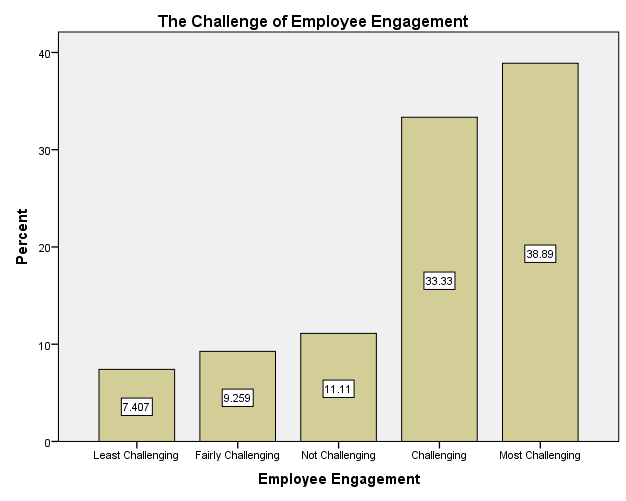
Similarly, Figure 2 shows that most employees (35.19%) rated planning as the most challenging followed by 29363% who rated it as challenging. Comparatively, 9.26%, 12.96%, and 12.6% of employees rated planning as least challenging, fairly challenging, and not challenging respectively.
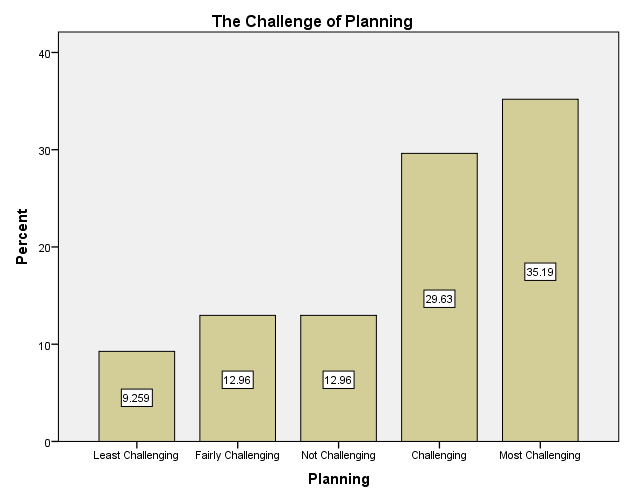
In the aspect of execution and re-engineering, the findings (Figure 3) show that most employees (27.78%) perceived it as fairly challenging while the same proportion of employees (20.37%) perceived it as challenging and most challenging. However, 9.26% of employees rated planning as the least challenging while 12.96% remained undecided.
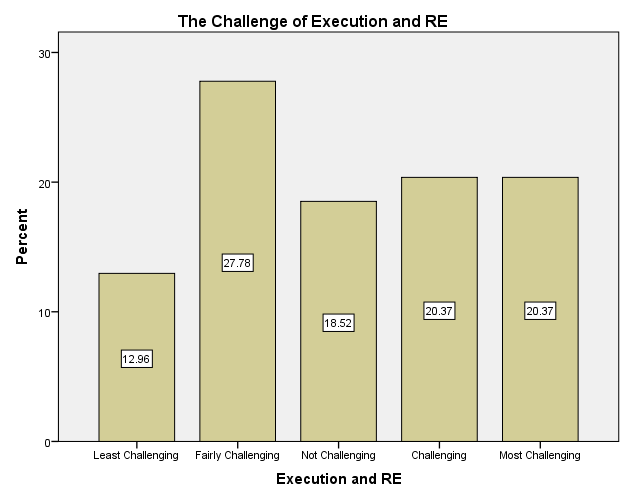
Concerning the aspect of monitoring and control, the findings in Figure 4 shows that most employees (27.78%) rated it as challenging followed by 24.07% who rated it as most challenging. Relatively, 5.56%, 2.37%, and 22.22% rated monitoring and control as least challenging, fairly challenging, and not challenging, correspondingly.
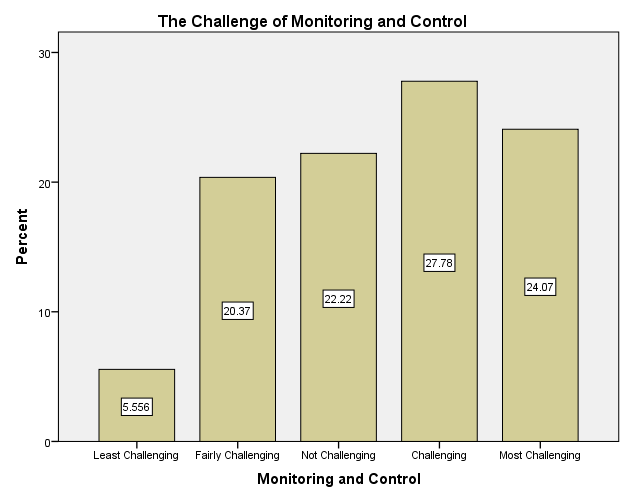
The findings in Figure 3 demonstrates that 27.78% of employees rated evaluation of results as the most challenging and 20.37% rated it as challenging. In comparison, 7.41% rated evaluation of results as least challenging, 25.93% rated it as fairly challenging, and 18.52% rated evaluation of results as not challenging.
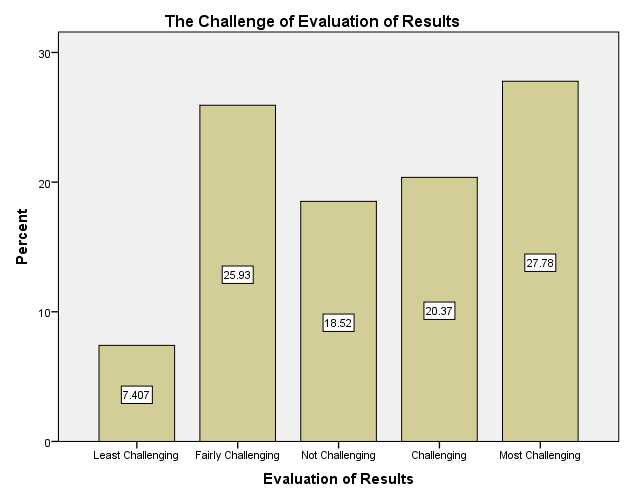
Implementation of RE
In the assessment of the RE process involved in the implementation of SS in DEWA, Table 5 illustrates that most employees 38.9% and 31.5% agree and strongly agree that the RE process is timely, premature, post-due, thoroughly planned, sufficiently funded, supplied with necessary materials and resources, carefully implemented, sufficiently monitored, and successful. In contrast, 9.3%, 13%, and 7.4% of employees strongly disagreed, disagreed, and remained undecided in their assessment of the extent of RE implementation. Comparison of SS implementation and RE implementation shows that they have a significant relationship, in line with the observation of Mola et al. (2015). Also, the discrepancies in timeliness and funds assessment again suggest the subjective nature of these assumptions (Creswell, 2013).
Table 5.
In the resolution of challenges, 75.93% stated that they have participated in the resolution of diverse challenges while the remaining 24.07% stated that they have not participated in the resolution of any form of challenges. The challenges entailed planning, adoption, implementation, monitoring, assessment, team management, and achievements of objectives, all of which have been mentioned in the literature, for example, by Al-Jenaibi (20150, 2016).
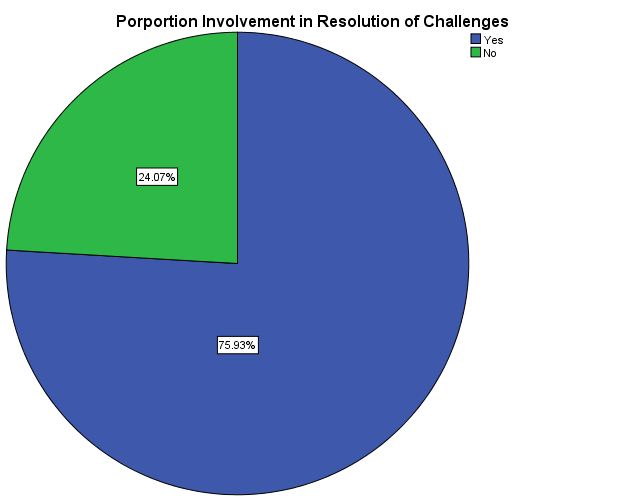
Assessment of Goals and Objectives
In their assessment, most employees (57.41) perceive that the project has achieved or in the process of achieving expected goals and objectives while 27.78% of employees perceive that the project has not achieved its goals and objectives.
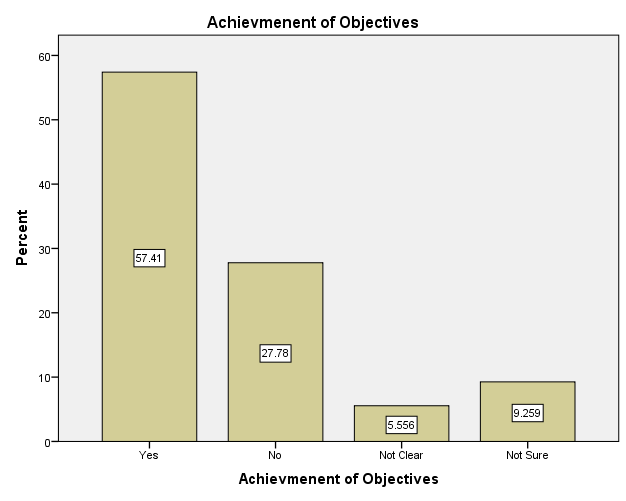
Following the implementation of SS, the employees noted that there are noticeable results. Figure 8 shows that 24.1% of employees observed that SS implementation increased the quality of services, 27.8% observed that it increased customer satisfaction, and 16.7% observed that it increased employee satisfaction. In contrast, small proportions observed that SS implementation decreased the quality of service (7.4%), employee satisfaction (3.7%), and customer satisfaction (5.6%). The results findings are very important, but they may have been warped by the insider bias (Coghlan & Brannick, 2014).
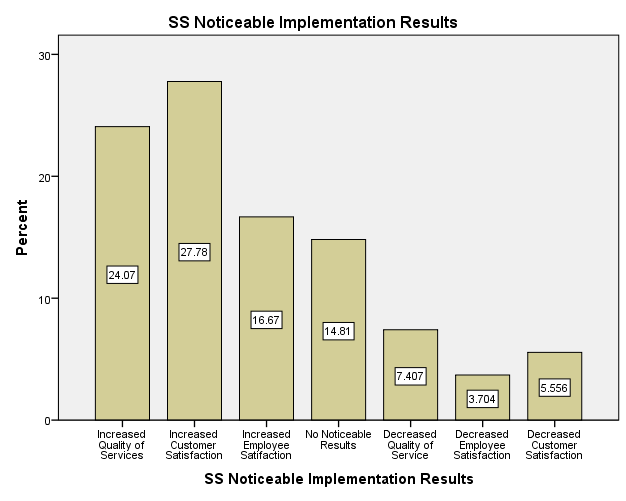
From their personal perspective, most employees perceive that SS is necessary for DEWA because it improves their working experience, enhances efficiency in the workplace, and provides satisfactory outcomes, which corresponds to the suggestions of Al-Jenaibi (2015, 2016) on the positive impacts of SS.
In predicting the future of DEWA, Figure 6 depicts that most employees (50%) predict that SS is durable while 42.59% predict that SS is modifiable. These findings reflect the assertion of Klischewski (2011) that resilience and responsiveness to changing dynamics are key attributes of SS. However, 7.41% predict that the future of SS is flawed.

Discussion
The findings that are presented above can be used to make a couple of important assumptions. In particular, the findings indicate that about a third of employees at DEWA had little (1 year or less) to no experience in the field of both SS and RE; another third had no more than 3 years of experience in SS, and another fourth had no more than 3 years of experience in RE. At the same time, as pointed out by Al-Jenaibi (2015), the lack of skill is among the key issues that can hinder the successful implementation of SS and RE. Similarly, the lack of training also suggests that the organization of the process could have been more efficient, and the problem of inefficient organization is among the challenges that plague SS in Dubai (Al-Jenaibi, 2016). As a result, the question of employee and managers’ training seems to be rather acute at DEWA.
Another interesting finding is the fact that employee engagement turned out to be the most challenging aspect of SS and RE implementation at DEWA as perceived by its employees; it was closely followed by planning. Also, every mentioned aspect was chosen as the most challenging one by at least 20% of the employees, and the majority of them correspond to the topics highlighted in literature research, for example, by Al-Jenaibi (2015). However, the more highly ranked issues seem to be particularly important for DEWA. In fact, they may indicate that the company is not sufficiently equipped to deal with these issues: possibly, the existing strategies or tools are not sufficient.
Finally, the findings that indicate the success of SS implementation (its durability, positive impact, goal achievement) are optimistic. However, the fact that some employees point out negative results suggests that the findings might have been warped by the insider or other bias (Coghlan & Brannick, 2014; Creswell, 2013). As a result, additional studies may be required to make certain statements about the results of the implementation.
Conclusion
The present paper reports on the research that was devoted to the review of SS implementation and related RE at DEWA as perceived by the employees. The findings indicate that the majority of employees find SS and RE important for the company, and many of them have experienced positive results; at the very least, their self-reported job satisfaction can be believed to increase. However, the study also revealed issues, including insufficient training and, supposedly, ineffective employee engagement and planning management. As a result, the following recommendations can be suggested.
Recommendations
Based on the findings, the continued improvement of DEWA’s SS requires training of managers and employees to enhance the adoption and implementation of SS and RE (Al-Jenaibi, 2016; Hashmi & Khanna, 2016). Moreover, experts are necessary to aid in overcoming challenges associated with planning, implementing, evaluating, monitoring, and troubleshooting issues. Particular attention should be paid to planning and employee engagement; the newly gained experience can be used to achieve this end.
Scope for future research
Future research can be aimed at eliminating the limitations that are described above and below; in particular, additional research (especially with the help of external researchers) can prove or show the mistakes in the employees’ perceptions on the results of the innovation (Coghlan & Brannick, 2014). Apart from that, follow-up research of a similar type (insider research) can be used to monitor the innovation’s results and durability as well as the changes in the employees’ perceptions. Finally, since the field of SS and RE studies is rapidly developing (Kusek et al., 2014), other case studies in other organizations can also be of interest for future research.
Limitations of the Research
The limitations of the research are inherent: as a case study, it is not too generalizable, and the size of the sample (54 people) contributes to this limitation (Creswell, 2013). Apart from that, the perceptions of the employees (insiders) are not always a reliable source of information as demonstrated above (Coghlan & Brannick, 2014). These limitations can be eliminated in future studies.
References
Al-Jenaibi, B. (2015). The New Electronic Government. International Journal Of Knowledge Society Research, 6(3), 45-74. Web.
Al-Jenaibi, B. (2016). Upgrading Society with Smart Government. International Journal Of Information Systems And Social Change, 7(4), 20-51. Web.
Al-Khouri, A. (2011). An Innovative Approach for E-Government Transformation. International Journal Of Managing Value And Supply Chains, 2(1), 22-43. Web.
Bhatnagar, S. (2009). Unlocking e-government potential. New Delhi: SAGE Publications, India.
Burke, D., Yu, Y., & Mckenna, P. (2014). A capability map of effective and efficient delivery of Telecom managed services. 2014 11th International Conference on Service Systems and Service Management (ICSSSM), 1, 1-5. Web.
Coghlan, D., & Brannick, T. (2014). Doing action research in your own organization (4th ed.). London: Sage.
Creswell, J. (2013). Research Design. Thousand Oaks, CA: SAGE Publications.
Davenport, T. (2013). Process innovation. Boston, Mass.: Harvard Business School Press.
Dolicanin, C., Kajan, E., Randjelovic, D., & Stojanovic, B. (2014). Handbook of research on democratic strategies and citizen-centered e-government services. London, UK: IGI Global.
Dubai Electricity and Water Authority. (2016). MD & CEO of DEWA and President & CEO of KEPCO conduct ground-breaking of Smart Grid Station. Web.
Hashmi, G., & Khanna, P. (2016). E-governance: A journey of challenges, failures, and success in India. International Journal of Innovative Research in Computer and Communication Engineering, 4(5), 8366-8373. Web.
Holecek, J., Brabec, Z., & Tikovsky, V. (2014). Smart Grids process framework assessment through process modeling. Mechatronika 2014, 1, 1-7. Web.
International Business Publications. (2016). United Arab Emirates internet and e-commerce industry investment and business guide. New York, NY: International Business Publications.
Klischewski, R. (2011). Architectures for tinkering? Contextual strategies towards interoperability in E-government. Journal of Theoretical and Applied Electronic Commerce Research, 6(1), 26-42. Web.
Kumar, V. (2015). E-Governance for Smart Cities. Singapore: Springer Singapore.
Kusek, J., Verheijen, A., & Bhatti, Z. (2014). Logged on: Smart Government Solutions From South Asia. New York, NY: The World Bank Group.
Millard, J. (2011). Are You Being Served? International Journal of Electronic Government Research, 7(4), 1-18. Web.
Mola, L., Pennarola, F., & Za, S. (2015). From information to a smart society. Cham, Germany: Springer.
Morton-Huddleston, W. (2012). Government accountability: Looking toward 2013.The Journal of Government Financial Management, 61(4), 33-36. Web.
Sun, G., & Shen, J. (2014). Towards organizing smart collaboration and enhancing teamwork performance: A GA-supported system oriented to mobile learning through cloud-based online course. International Journal of Machine Learning and Cybernetics, 7(3), 391-409. Web.
Appendix A: Questionnaire
Thank you very much for agreeing to participate in the present study! This questionnaire will help us to examine the re-engineering processes that DEWA has used to implement its Smart Services (SS). Given your direct experience on the matter, we ask you to respond to the following questions while paying attention to their instructions. Please feel free to skip questions if you find that you cannot or do not want to respond to them. No personal information will be disclosed, and the final report of the study will not contain your name or attempts to identify your responses.
Your Role in the Project
- What part did you take (have been taking) in the implementation of SS at DEWA?
- Project manager
- Team member
- Consulting activities
- Other
- Have you had any prior experience in the field of SS?
- Yes, ___ years
- No.
- Have you had any prior experience in the field of process re-engineering?
- Yes, ___ years
- No
DEWA and SS
- Do you think that the senior management of DEWA considers SS necessary? Why or why not? _____ ______ _____ ______ ___
- Consider the SS implementation project at DEWA. Do you find that it has been:
- Rate the following aspects of SS implementation. Insert numbers where 1 stands for “the most challenging” and the last number (e.g., 5) for “the least challenging.”
- Did the process of SS implementation involve major re-engineering? What did it entail?_____ ______ _____ ______ ___
- Consider the re-engineering process that was involved in the SS implementation. Do you find that it has been:
- Have you been engaged in the resolution of particular challenges throughout the implementation of the project? What did they entail?_____ ______ _____ ______ ___
- Did the project achieve its goals? Is it moving toward achieving its goals?
- Yes.
- No.
- It is not clear yet.
- I am not sure.
- I want to elaborate: _____ ______ _____ ______ ___
- What SS implementation results are noticeable at the moment? You may choose several options.
- Increased quality of services. Feel free to specify the aspect of the quality:
- speed
- efficiency
- other __________________________________.
- Increased customer satisfaction
- Increased employee satisfaction
- No noticeable results
- Decreased quality of service
- Decreased employee satisfaction
- Decreased customer satisfaction
- Other _______________________________________
- Do you personally think that SS is necessary for DEWA? Why or why not?_____ ______ _____ ______ ___
- Are you personally satisfied with the results? Why or why not?_____ ______ _____ ______ ___
- What do you think is going to happen to DEWA’s SS in the future?
- It is durable, and it will be used for a while.
- It is modifiable, and it will be improved.
- It is flawed, and it will be dismantled.
- Other _____ ______ _____ ______ ___
- Please make suggestions on the continued improvement of DEWA’s SS if you have any in mind. _____ ______ _____ ______ ___
Appendix B: Tables
Table 1.
Table 2.
Table 3.
Table 4.
Appendix C: Resume
The present paper is a final report on a study that was carried out at the Dubai Electricity and Water Authority (DEWA) with the aim of investigating the challenges and processes of smart services (SS) implementation and related re-engineered processes (RE) in the organization as perceived by its stakeholders. The paper provides theoretical information on SS and RE, explains the methodology and scope of the study, presents findings, and makes conclusions and recommendations while pointing out the limitations. The findings indicate that changes in training, planning, and employee engagement practices might be required, which can be informed by the newly gained experience. Also, it is concluded that additional research can help to make a more reliable assessment of the results of the innovation.
